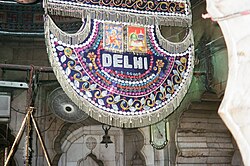
Back फूल वालों की सैर Hindi पुष्पोत्सवः Sanskrit Пфоол-Валон-Кі-Сайр Ukrainian پھول والوں کی سیر Urdu
| Phool Waalon Ki Sair | |
|---|---|
 A floral Pankha (fan) over the Idol of Yogmaya in the sanctum sanctorum, Yogmaya Mandir | |
| Dates | September [citation needed] |
| Location(s) | Mehrauli, New Delhi |
| Founded | 1814 |
| Website | https://phoolwaalonkisair.co.in |
Phool Waalon Ki Sair meaning "procession of the florists" is an annual celebration by the flower sellers of Delhi. It is a three-day festival, generally held in the month of September, just after the rainy season in the region of Mehrauli. It is seen as an example of the composite culture of Delhi, which has bolstered an environment of communal harmony in the city, and even today the festival is celebrated by both Hindus and Muslims alike.[1]
This secular festival involves a procession, led by shehnai players and dancers, and bearing large floral fans, pankhas, to Yogmaya Temple, the shrine of Devi Jog Maya, and winds through Mehrauli Bazar, to reach the dargah of 13th century Sufi saint, Khwaja Bakhtiyar Kaki.[2]
Also known as Sair-e-Gul Faroshan during this three-day festival, the flower sellers pray for a better flower season in the coming year by offering big fans, pankhas, embroidered with flowers to both shrines. [citation needed] [3][4]
Just as when it was first conceived and had the Mughal Emperor as its patron, these days the festival has the Prime Minister of India as its main patron; Jawaharlal Nehru who revived and inaugurated the festival in 1962, and all the PMs hence, have equally participated in the festival. Another tradition is to offer a similar floral pankha to the President of India, Chief Minister of Delhi, and also the Lt. Governor of the city. Recent additions are the cultural troupes from various states of India, which perform songs, dances, and drama at the main function which is held at 'Jahaz Mahal' in Mehrauli, located in a corner of 'Hauz Shamsi' and is believed to have been built in Lodhi dynasty era, takes the festival beyond its vision of communal harmony to that of national integration [1][5][6]
- ^ a b Communal harmony, the Delhi way The Hindu, 18 October 2004.
- ^ Delhi: a portrait, by Khushwant Singh, Raghu Rai, Published by Delhi Tourism Development Corp., 1983. ISBN 0-19-561437-2. Page 15.
- ^ Phool Walon Ki Sair India: A Splendour in Cultural Diversity, by Paulias Matane. Published by Anmol Publications, 2004. ISBN 81-261-1837-7. Page 129.
- ^ 5 October 2001 Press Information Bureau, Govt. of India. "The President Shri K.R. Narayanan receiving the ' Pankha' of Phool Walon Ki Sair from the members of Anjuman Sair-e-Gul Faroshan in New Delhi on October 5, 2001."
- ^ President A.P.J. Abdul Kalam: 2004-2006, by S. K. Dhawan. Published by Abhi Books & Distributors, 2007. ISBN 81-904675-1-4. pp 710."2004 October 6 (Wednesday) PHOOL WALON KI SAIR President Kalam received a pankha of flowers from the members of Anjuman Sair-e-Gul Faroshan"
- ^ "Kalam presented floral 'pankha'". The Tribune. Chandigarh. 7 October 2004. Retrieved 25 February 2019.